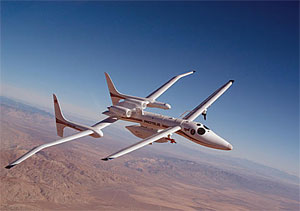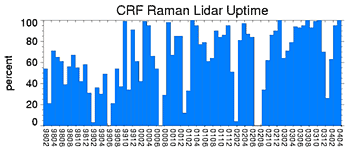Operations Updates
ARM Climate Research Facility Operations Update - September 30, 2004
This bimonthly report provides a brief summary of significant accomplishments and activities in the operations area of the ARM Climate Research Facility (ACRF).
New Instrumentation on Proteus Aircraft Tested
This fall, the ARM-Unmanned Aerospace Vehicle Program—specifically, the Proteus aircraft—is participating in the Mixed-Phase Arctic Cloud Experiment (M-PACE) in Alaska. However, several of the aircraft's onboard instruments have been modified since its last deployment in November 2002. To verify instrument operation and calibration prior deployment as part of M-PACE, in late September 2004, ARM researchers flew the Proteus from Mohave, California, out over the Pacific Ocean to collect radiometric, remote sensing, and in situ data for analysis. The aircraft flew over low marine cloud cover and clear skies over the ocean, also taking observations within and above cirrus clouds.

The Proteus, one of two aircraft taking part in the Mixed-Phase Arctic Cloud Experiment in Alaska during October 2004, is equipped with microphysical and radiometric instrumentation to document cloud properties.
Researchers plan to conduct one or two more test flights before sending the aircraft to Alaska for participation in M-PACE. Of specific interest in the Proteus payload is the 95 GHz cloud radar (equipped with a new transmitter) and the short-wave broadband irradiance radiometers (with new preamplifiers and digitizers). Data recorded during the flight tests will be reviewed for quality, then made available to interested reviewers, and added to the ACRF Data Archive as well. Data quality and instrument performance will continue to be assessed throughout the experiment.
The primary research objective for the M-PACE is to collect a focused set of data needed to advance the understanding of dynamic processes in arctic mixed-phase clouds, including cloud microphysical processes and radiative transfer through clouds. These data sets can then be used in computer models that simulate the arctic climate. As one of two aircraft equipped with downward looking sensors during the experiment, the Proteus will fly between four ground stations, obtaining data to complement the surface based measurements. Combined, these observations will document the full breadth of cloud and radiative transfer processes in mixed-phase arctic clouds in the study area.
Raman Lidar Refurbishment and Upgrade Completed
During the past several years, the sensitivity of the 8-year old Raman lidar at the ACRF Southern Great Plains (SGP) site has decreased between a factor of 3-4, resulting in a lower maximum altitude and increased random error in the geophysical properties (such as water vapor mixing ration and aerosol extinction profiles) derived from lidar. In September 2004, a ten-month effort to refurbish and upgrade the aging lidar was completed, as ARM scientists visited the site to align the instrument's newly-refurbished receiving telescope, install new interference filters, and optimize signal levels. Replacing the telescope and interference filters returned the lidar's sensitivity back to its original levels, while upgrades to the detection electronics - and subsequent removal of the neutral density filters - boosted the signals in the nitrogen and aerosol channels an order of magnitude, resulting in a substantial improvement in the capability of the lidar for water vapor, cloud, and aerosol studies.

A unique capability of the SGP Raman lidar is the ability to automatically switch between daytime and nighttime operations. This provides continuous, uninterrupted multiple-day measurements, as shown by this chart with uptime data in monthly increments from February 1998 through April 2004.
Following several years of deteriorating performance by the Lidar, a committee was formed in December 2003 to recommend ways to restore the instrument's performance and recommend improvements and future upgrades. Based on the committee's recommendations, many optical elements were replaced, including the external window, the input lens to the beam-expanding (transmit) telescope, and beam-turning mirrors. However, these changes had minimal impact on signal levels, so the decision was made to refurbish the telescope and replace the interference filters. In May, ARM scientists installed new signal processing and data acquisition electronics from Licel, combing both analog and photon counting into a single package. Then, in June, the 24-inch, 200-pound receiving telescope was sent to the vendor to have all three mirrors resurfaced. The refurbished telescope was reinstalled by SGP Operations staff in August in preparation for the final alignment, filter installation, and signal optimization activities in September.
Data from the SGP's Raman lidar - the first operational turn-key Raman lidar in the world - are critical for various projects in the ARM Program's Aerosol Working Group, and provide unique and valuable data for cirrus cloud property studies. Future improvements to the lidar system include refinements to the automatic alignment capability, and possibly additional channels for measuring temperature profiles and liquid water in thin clouds.
Narrow Field of View (NFOV) Radiometers Deployed

The 1-channel (left) and 2-channel (right) NFOV radiometers are collocated with the infrared thermometer (green stripe) at the SGP Central Facility. Numerous other instruments are situated nearby..
In September 2004, ACRF Operations staff installed a new 2-channel Narrow Field of View (NFOV) radiometer at the Southern Great Plains (SGP) site. They also installed a repaired 1-channel NFOV radiometer that had been damaged by lightning in June 2002. As reported in August, the 1-channel NFOV measures spectral radiance at 870 nm, while the new 2-channel NFOV measures at both 673 nm and 870 nm. The additional measurement better supports cloud research by the ARM Science Team, particularly in developing cloud optical depth algorithms and retrieval methods for broken cloud fields.
Both NFOV radiometers are now collocated at the SGP site with the Infrared Thermometer that measures brightness temperatures at 10 µm, and are also in close proximity to the microwave radiometer, which measures water vapor and liquid water. Because their fields of view overlap, the various instruments are able to obtain cloud property measurements from the same area in an atmospheric column. The original 1-channel NFOV was deployed to provide a redundant check on data quality for the new 2-channel version; the 1-channel NFOV may eventually be moved to another ACRF site.



